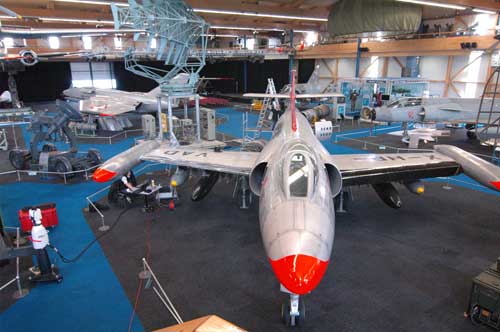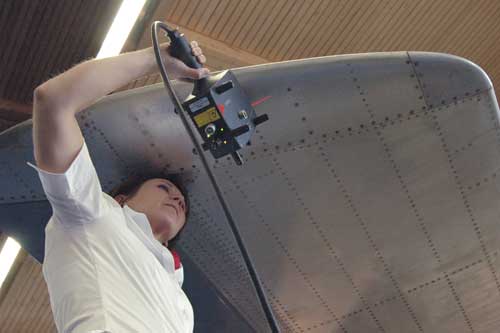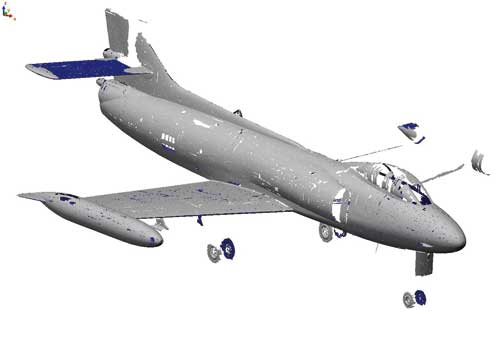Cold-War Era Swiss Jet Reverse Engineered for Aerodynamic Testing; Leica T-Scan Digitizes Entire Aircraft Surfaces
When computing flight performance characteristics and aerodynamic behavior of an entire aircraft, the calculations are challenging in the best of circumstances.
August 31, 2011
By Belinda Jones
Editor’s note: This article is sponsored by Hexagon Metrology / Leica Geosystems.
More often than not, industrial metrology involves performing measurements on parts and assemblies of precision products like cars, satellites, and wind turbines. Rare is the opportunity to measure a celebrated relic of modern historysuch as an entire bomber jet. Enter the P-16.
This story starts in 1948, following the then-emerging Cold War world order. Surrounded by war-torn countries during WWII, Switzerland managed to escape armed conflict entirely and was diligently guarding its armed neutrality. The High Command of the Swiss Air Force was interested in developing a ground attack jet fighter to replace the obsolete piston-engined D-3802 and C-3604 aircraft that were in service at the time. The new jet would implement flight and payload characteristics specially tailored to suit the complex Swiss topography of narrow, high-mountain valleys. The demanding requirements included a near-supersonic top speed, excellent maneuverability and the ability to land and take off on extremely short runways that are typical in alpine regions.

The only remaining P-16 fighter jet on display at the D bendorf Aviation
Museum near Z rich, Switzerland.
The first prototype had its maiden flight in 1955. The one seat, single-engine plane featured a revolutionary wing design with a thin profile and a unique combination of trailing edge flaps, drooping ailerons and Kr ger-type leading edge flaps, which increased the lift significantly. As a result, the P-16 could start on runways under 500 meters in length, and perform landings that required a mere 300 meters. The second prototype powered by its 7,900 lb. Armstrong Siddeley Sapphire 6 turbojet engine exceeded the sound barrier for the first time in 1956.
In 1958, the Swiss Air Force ordered 100 P-16 tactical fighters. However, the entire project was doomed when two prototype crashes related to minor mechanical problems lead the Swiss government to terminate the project and cancel the entire order. Fortunately, the plane’s revolutionary low aspect-ratio wing design was reincarnated in the first-ever business jets made by Learjet. These pioneering business jets incorporated many of the P-16 design features, which were bold at the time of their introduction. In reality, the plane was simply 10 to 15 years ahead of its time. Unfortunately, none of the original engineering drawings have survived. Only one P-16 airplane remains, and it is exhibited at the D bendorf Aviation Museum near Z rich, Switzerland.
Capturing History
The performance of this gem was not lost in the annals of history. The P-16’s reported STOL (short take-off and landing) performance, responsiveness at high speeds and low altitudes, high power and top-notch low-speed handling were all alluring factors for Marc Immer, an aspiring mechanical engineering student at ETH, the Swiss Federal Technical Institute located in Z rich. Immer wanted to fully digitize the last existing P-16 and analyze its aerodynamic properties by testing its scaled model in a wind tunnel.
After evaluating several scanning solutions, Immer determined the Leica T-Scan from Leica Geosystems was the right fit for the data acquisition part of the project. Other scanning options either lacked the required high accuracy or did not provide a large enough measurement volume to encompass the P-16 jet’s vast surfaces. Leica Geosystems liked the research project so much that they offered to team up with Immer to help with the scanning process.

Scanning the P-16 to gather the more than 40 million points needed to
create a 3D polygonal model.
The bomber is more than 14 meters long, 4 meters tall, with an 11 meter wingspan. The plane has a large surface area, with the wings alone covering 30 square meters. The Leica T-Scan is a handheld laser scanner that works in tandem with a Leica Absolute Tracker, a portable CMM that relies on a laser beam to accurately measure and inspect in a large spherical measurement volume up to 30 m (98 ft). The laser tracker captures 3D surface data in 3 different ways: 1) by following a small mirrored sphere, 2) by tracking a wireless, armless contact probe, or 3) by tracking a hand-held scanner, which is the case with the P-16 project.
How the Scanner Works
The non-contact, high-speed scanner provides a measurement sampling rate of 20,000 points per second. When in use, the operator’s movement is similar to holding a brush and painting dimensions upon the aircraft’s wing or fuselage surfaces. The operator also gets visual feedback from an intuitive LED pattern for accurate information about the optimal scanning distance or angle from the object. Not just a line scanner, the device’s Flying Dot technology performs measurements by sweeping the triangulation plane over an angle using a rotating mirror, and automatically adjusts the laser intensity to obtain the best measurement of an object’s exterior, such as shiny metallic or dark surfaces.
The Leica T-Scan works with the laser tracker through the use of a digital camera system (Leica T-Cam) that operates with visible light and infrared (IR) radiation. The system uses an optical vario zoom and a motor for vertical, angular movement. Mounted on top of the laser tracker, the camera system continuously “tracks” the hand scanner and captures images. The camera’s incremental angle encoder provides the vertical angular movement of the camera itself based on tracker guidance angles. A Digital Signal Processor (DSP) located within camera performs all calculations and image processing tasks. Its zoom lens group is completely sealed in the camera body. This design allows very stable and repeatable measurements.
Regardless of whether measurements are taken in direct sunlight or in an industrial setting with starkly changing environmental light, the hand scanner is impervious to varying environmental light conditions. This capability eliminates the need for special protection setups and significantly reduces the preparation phase. This third generation scanner has a doubled data acquisition rate of 20 kHz, which means that large surfaces can be captured in half the time compared to the previous versions of the device. Instant temperature compensation is built into the system for measurements in almost any conditions.
Scanning the P-16
Over the course of two working days, a total of 40 million points were collected during the P-16 scanning operation. In fact, at 20,000 points per second, the dense point cloud looks like a photo of the aircraft as the data is displayed on a computer screen. The scanner’s four faces provide multiple angles of access to the object’s face so the tiniest details can be expertly captured. Based on the laser tracking technology, the operator can develop a local coordinate system, and then tap into a larger coordinate system.

A polygonal model of 7,185,137 triangles was created using PolyWorks software
from InnovMetric Software. PolyWorks editing tools were used to optimize the model.
To create a 3D model that would be usable for CAD (Computer Aided Design) applications, the collected data was imported into PolyWorks from InnovMetric Software Inc. The software was used for point cloud processing and the creation of a 3D polygonal model of 7,185,137 triangles representing the high definition surfaces of the P-16 aircraft. Using advanced algorithms, PolyWorks averages all data points and merges them to create a meshed model representation. Using PolyWorks editing tools, the full-scale model was further optimized to produce a usable and accurate digital replica of the historic aircraft. The data processing and optimization was performed by an application specialist from Duwe-3d AG in Lindau, Germany, a partner of InnovMetric Software.
“My intention is to recalculate the performance data of the aircraft,” states Immer. “Calculations of flight performance characteristics such as ascent and descent rates, stall speeds, as well as the plane’s aerodynamic behavior with the lowered and retracted flaps, will deliver the kind of information that has never existed for this aircraft due to the sudden termination of the project and the nearly complete absence of documentation relating to the development, and the consequent flight tests. Getting involved in the P-16 project has made this research extremely worthwhile, giving me valuable real-world experience using the most advanced industrial metrology equipment available on the market.”
The physical model of the P-16 was completed this past summer. Wind testing was conducted on the wing as a student research project last semester. Results are currently being analyzed at the ETH. Testing of the full model will begin in a future semester as another significant project for the Swiss engineering students.
For More Information, Visit:
hexagonmetrology.us/about-us/our-brands/leica-geosystems
About Hexagon Metrology
Hexagon Metrology serves the high precision measurement and inspection needs of worldwide manufacturers with its extensive line of metrology hardware, software, accessories and customer services. The company’s name-brand portfolio of quality assurance products include Brown & Sharpe, Cognitens, Leica Geosystems, ROMER, Sheffield, PC-DMIS, DEA, Leitz and TESA. Hexagon Metrology has an unrivaled installed base of more than 1.5 million handheld, stationary and portable measurement devices, and over 35,000 seats of PC-DMIS metrology software. More information is at http://www.HexagonMetrology.us.
The company is a business unit of Hexagon AB (Stockholm, Sweden), a publicly-traded company (Nasdaq OMX Stockholm: HEXA B). The Hexagon group consists of nearly 11,000 employees located in 42 countries.
About the Author
Belinda Jones is the founder and owner of HiTech Marketing LLC ( Westbrook, Connecticut). For more than a decade, Jones has written articles and commentaries about manufacturing, engineering, quality assurance, CAD/CAM/CAE applications, and other high-tech topics. She has extensive experience in marketing communications, technical sales, and applications engineering. Before joining the computer industry, she was a broadcast copywriter for four years. Jones holds degrees in fine arts and mechanical engineering, and studied cultural arts in Europe.
Subscribe to our FREE magazine, FREE email newsletters or both!
About the Author
DE’s editors contribute news and new product announcements to Digital Engineering.
Press releases may be sent to them via [email protected].






